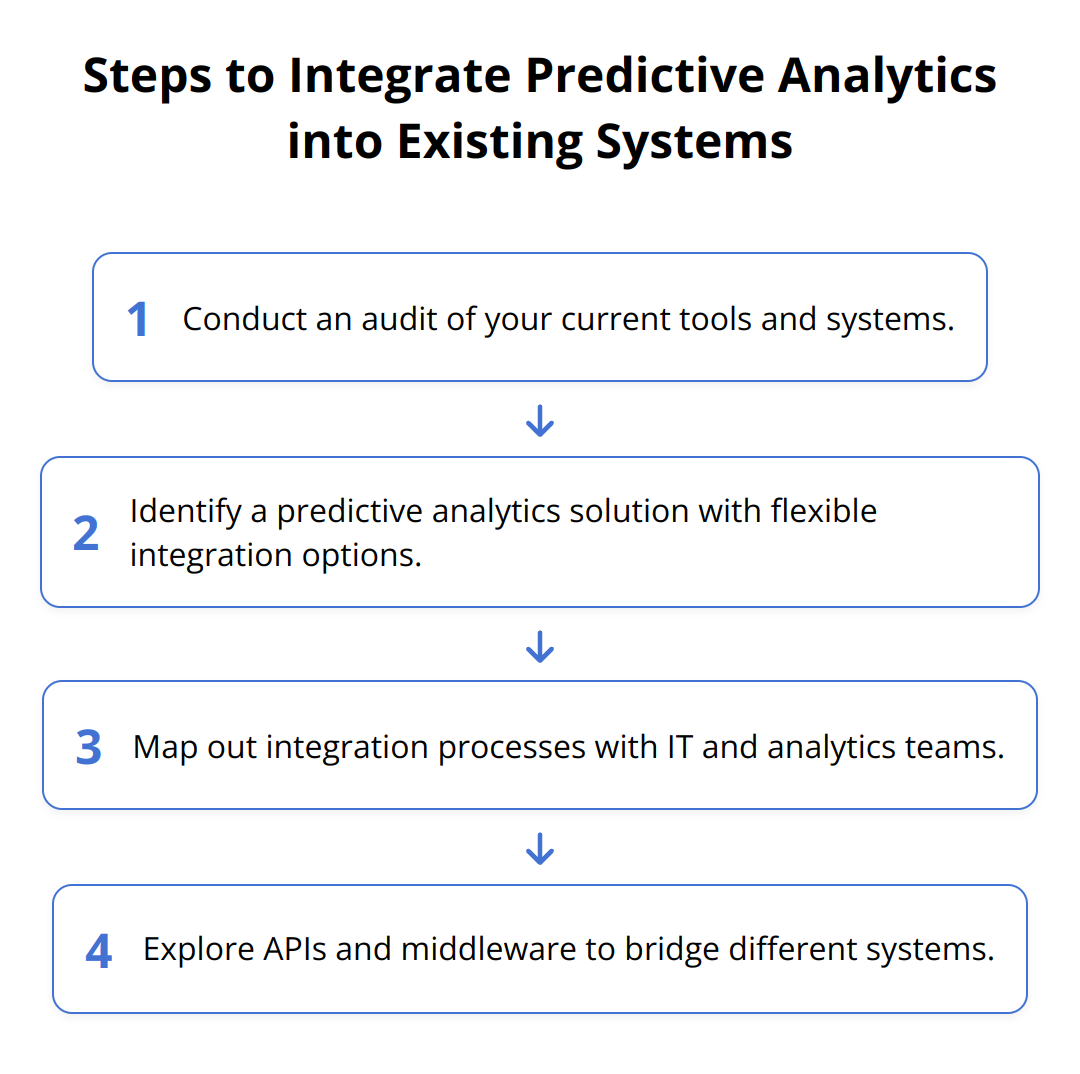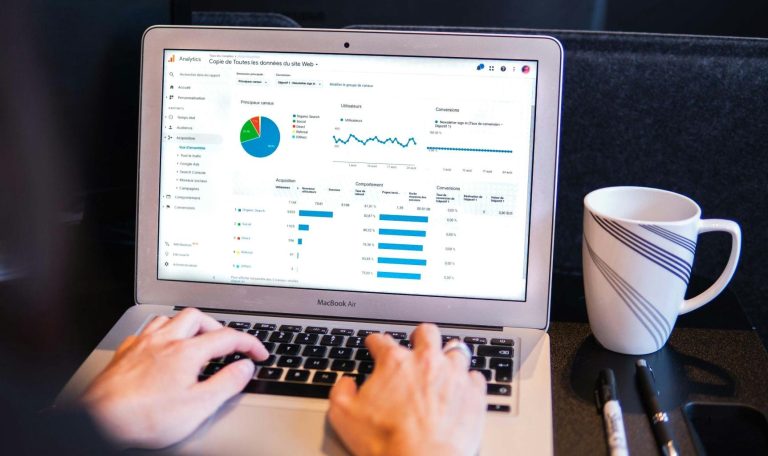Predictive analytics is transforming how B2B companies approach sales and marketing, creating opportunities to enhance performance and understand customer needs better. We at Emplibot believe that leveraging this technology is key for businesses looking to gain a competitive edge. By analyzing trends, improving lead scoring, and personalizing marketing efforts, companies can significantly increase their potential for success. This blog post explores the role of predictive analytics in B2B sales and marketing, challenges to its implementation, and its promising future.
Inhalt
ToggleHarnessing Predictive Analytics in B2B Sales
In the ever-evolving landscape of B2B sales, predictive analytics stands as a beacon of innovation, guiding companies towards more strategic decision-making and actionable insights. The integration of predictive analytics into sales strategies not only refines the process of identifying emerging trends but also elevates the efficiency of lead scoring systems and provides a robust framework for forecasting future sales performance.
Unlocking Sales Trends Through Data
In today’s competitive market, understanding and acting on sales trends before they become mainstream is essential. Predictive analytics offers that edge by mining vast datasets to reveal patterns and trends that might not be apparent at first glance. For instance, a slight change in purchasing behavior can signal an upcoming trend, enabling companies to adjust their sales strategies accordingly. This proactive approach ensures that businesses stay ahead of the curve, maximizing opportunities for growth.
Refining Lead Scoring
The traditional methods of scoring leads often rely on intuition or oversimplified criteria, which can lead to missed opportunities and wasted resources. Predictive analytics introduces a level of precision and personalization previously unattainable. By analyzing past interactions, purchase histories, and even social media behavior, predictive models can accurately score leads, focusing efforts on those with the highest conversion potential. This not only increases efficiency but also significantly boosts conversion rates.
For practical steps on improving lead scoring, explore our insights on B2B predictive analytics.
Forecasting Future Sales
One of the most powerful aspects of predictive analytics is its ability to forecast sales performance. This capability allows businesses to make informed decisions about inventory management, resource allocation, and strategic planning. By identifying patterns in historical data, predictive models can project future sales with a high degree of accuracy. This foresight facilitates better budgeting and financial planning, ensuring that companies are prepared for both the opportunities and challenges that lie ahead.

Here are a few tips for implementing predictive analytics in your sales strategy:
-
Data Quality is Key: Ensure your data is clean, comprehensive, and up-to-date.
-
Continuous Optimization: Regularly update your predictive models to reflect the latest data inputs.
-
Collaborative Integration: Align your sales and analytics teams for seamless implementation and use of insights.
-
Educate Your Team: Invest in training so your sales team can effectively interpret and act on predictive analytics insights.
By embracing predictive analytics, B2B companies can transform their sales strategies, making them more data-driven, efficient, and proactive. This strategic advantage not only enhances sales performance but also positions companies for sustainable growth in a dynamic business environment.
Enhancing B2B Marketing with Predictive Analytics
In the realm of B2B marketing, predictive analytics is a game-changer, empowering businesses to launch highly personalized campaigns, optimize marketing budgets, and anticipate customer behaviors and preferences with unprecedented accuracy. This transformative approach ensures that marketing strategies are not only more cost-effective but also significantly more impactful.
Tailoring Marketing to Every Customer
The true power of predictive analytics lies in its ability to craft personalized marketing messages that resonate with individual prospects. This level of customization goes beyond basic demographic targeting. It synthesizes data from past interactions, purchasing habits, and even online behaviors to create marketing materials that speak directly to the needs and desires of each recipient. The result? Dramatically improved engagement rates and conversion ratios. For guidance on hyper-personalization, our post on personalized marketing with AI is an invaluable resource.

Maximizing Marketing Spend Efficiency
Every marketing dollar must work harder in today’s competitive environment. Predictive analytics acts as a compass, guiding marketers on where to allocate their budgets for maximum return on investment (ROI). By analyzing the performance of past campaigns across various channels and customer segments, businesses can identify the most lucrative opportunities. This not only increases ROI but also prevents wasteful spending on underperforming strategies.
Anticipating Customer Needs
Understanding and predicting customer behavior is the holy grail of marketing. With predictive analytics, companies can forecast future buying patterns, preferences, and even potential churn. This insight allows marketers to proactively adjust their strategies, offer timely promotions, and address customer concerns before they escalate. Anticipating needs in this way not only boosts sales but also fosters loyalty by demonstrating a deep understanding of the customer’s journey.
Key Takeaways:
-
Personalization is paramount: Tailor marketing messages to individual customers for higher engagement.
-
Invest wisely: Use data to direct marketing spend toward the most effective channels and strategies.
-
Stay one step ahead: Predict customer behaviors to enhance loyalty and sales.
Incorporating predictive analytics into B2B marketing isn’t just a trend; it’s a strategic necessity for businesses aiming to stay competitive and grow. By leveraging the insights gleaned from data, companies can significantly enhance the effectiveness of their marketing efforts, leading to stronger relationships with customers and a healthier bottom line. For a deep dive into optimizing your content strategy with these insights, consider exploring how content strategy can be optimized.
As we continue exploring the impact of predictive analytics, it’s clear that this technology is not just changing the game; it’s redefining it. B2B marketers equipped with predictive insights have a unique advantage in crafting strategies that are not only efficient but also profoundly resonant with their target audience.
Tackling Predictive Analytics Challenges
Predictive analytics has the potential to revolutionize B2B sales and marketing, yet its implementation is often met with several hurdles. Businesses need to address these challenges head-on to unlock the full capability of this powerful technology. Here, we explore solutions to some of the most common obstacles encountered during deployment.
Navigating Data Hurdles
One of the first barriers to implementing predictive analytics is data collection and quality. High-quality data is the foundation of any successful predictive analytics strategy. However, collecting comprehensive data sets that are both accurate and relevant can be daunting.
Solution:
-
Conduct an audit of your existing data to identify gaps and inaccuracies.
-
Invest in data cleaning tools and technologies to ensure data quality.
-
Consider partnerships or third-party data providers to enrich your datasets.
Data quality directly impacts the effectiveness of predictive analytics. Without accurate, clean, and comprehensive data, your predictive models are likely to produce unreliable insights.

Ensuring Privacy and Security
With the increasing amount of customer data being processed, privacy and data protection are critical concerns. Regulations such as GDPR and CCPA mandate strict guidelines on how businesses can collect, store, and use customer data.
Solution:
-
Stay informed about data protection laws applicable in different regions.
-
Implement robust data security measures and conduct regular audits.
-
Prioritize transparency with customers regarding their data usage.
For insights on navigating these privacy regulations, consider reading about how to leverage sentiment analysis tools.
Integrating with Existing Systems
Another significant challenge is integrating predictive analytics with existing systems. Many businesses operate with a variety of tools and platforms, making seamless integration a complex task.
Solution:
-
Identify a predictive analytics solution that offers flexible integration options.
-
Work closely with IT and analytics teams to map out integration processes.
-
Explore APIs and middleware solutions that can bridge different systems effectively.
Effective integration ensures that your predictive analytics solutions complement your existing tools, enhancing rather than disrupting workflows.

Practical Tips for Success:
-
Start small with focused pilot projects to demonstrate value before scaling.
-
Foster a data-driven culture by involving stakeholders from different departments.
-
Consider external expertise to navigate complex integration and compliance issues.
Successfully overcoming these challenges not only sets the groundwork for harnessing the full potential of predictive analytics but also positions B2B companies for lasting competitive advantages. The key is to approach each hurdle with a strategic mindset, employing both technological solutions and organizational adjustments.
Final Thoughts
The journey through the potential of predictive analytics in B2B sales and marketing shines a spotlight on its significant impact. It’s not just about adapting to current trends; it’s about setting the stage for a future where data-driven decisions pave the way for unparalleled growth and efficiency. The advantages of integrating predictive analytics into business practices are clear, offering enhanced lead scoring accuracy, tailored marketing strategies, and the foresight to navigate market shifts proactively. This approach not only elevates sales and marketing efforts but fundamentally transforms how businesses engage with their customers, anticipate needs, and optimize operations.

The call for proactive adoption among businesses rings louder than ever. Embracing predictive analytics isn’t an option; it’s a necessity for those aiming to remain competitive in a rapidly evolving marketplace. The insights provided by predictive models offer a blueprint for success, guiding strategies with precision and foresight. However, leveraging this technology entails navigating challenges, from ensuring high-quality data to integrating systems seamlessly and maintaining stringent privacy standards. Addressing these hurdles is essential, fostering an environment where predictive analytics can thrive.
Looking ahead, the future of predictive analytics promises further evolution, with advancements in AI and machine learning technologies enhancing its capabilities. As these tools become more accessible and integration becomes streamlined, their adoption will likely become more widespread, setting new standards for efficiency and strategic planning in B2B sales and marketing. The businesses that capitalize on these opportunities today will be the ones leading the way tomorrow.
For those ready to harness the power of predictive analytics and stay ahead in the digital era, exploring tools that automate and optimize online presence, such as Emplibot, is a step in the right direction. With the ability to publish SEO-friendly articles automatically, including comprehensive keyword research and internal linking, Emplibot empowers businesses to build their blog effortlessly, ensuring they remain visible and relevant in an increasingly competitive online landscape.
In closing, the journey with predictive analytics is just beginning. Its potential is vast, and its impact profound. By leveraging this technology wisely and proactively, businesses can unlock doors to innovation, efficiency, and sustained growth in the B2B realm. Let’s embrace this future, armed with knowledge and the right tools, ready to transform challenges into opportunities.











